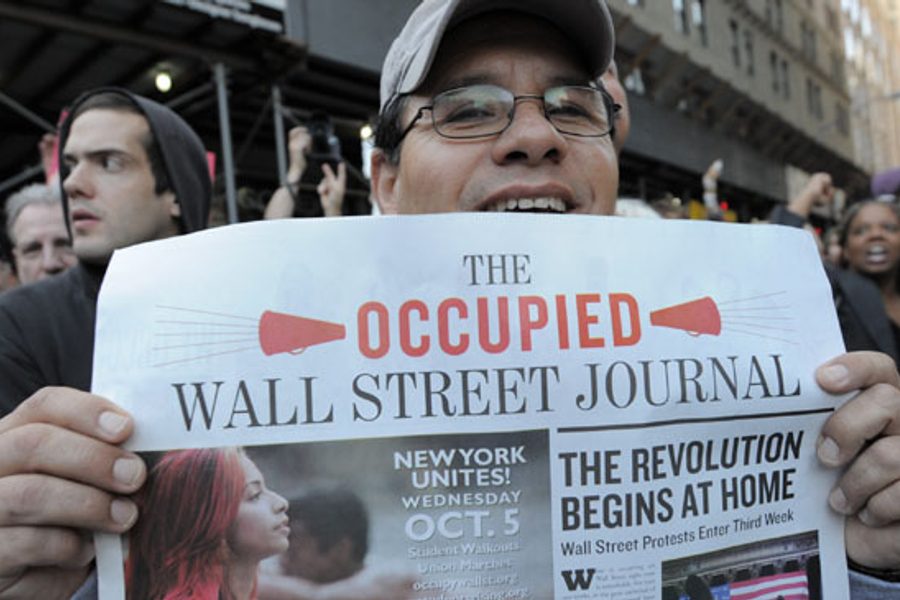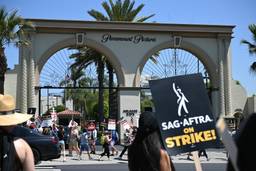Occupy the Press
Despite the media’s atrocious coverage, the Occupy protests have clearly changed the nation’s conversation.
Susan J. Douglas

So here’s the question: Despite the media’s appalling coverage of the Occupy Wall Street movement, is a more sustained and sustainable assault on the injustices of corporate capitalism gaining a foothold?
With the emergence, and spread, of the Occupy movement, the first scandal was the mainstream media’s ignoring the story (until the NYPD got violent). Many noted, rightly, that if the demonstration had been organized by the Tea Party, the press would have been all over it from the start. The second scandal, once the media did start to pay attention, was the dismissive, marginalizing coverage – the New York Times possibly being the worst – casting the demonstrators as clueless, leaderless neo-hippies simply looking for a way to pass sunny autumn afternoons.
Ginia Bellafante’s article was a textbook case of trivialization. She likened the demonstration to a “carnival,” described a “half-naked woman” as the movement’s “default ambassador,” and noted that the group’s cause “was virtually impossible to decipher,” adding that most of the demonstrators had “traveled from somewhere else… with drums, horns, tambourines and, in the instance of one young man, a knee-length burlap vest, fur hat, ski goggles and tiny plastic baby dolls applied to the tips of his fingers.” Possibly the most inadvertently ironic headline was the Times’ “In Private, Wall St. Bankers Dismiss Protesters as Unsophisticated.” Hmm, those same highly sophisticated bankers who got us in this mess in the first place?
Many of us become so infuriated by coverage like this because we believe that news frames matter, that they shape how millions view a story. The news media’s influence can be especially powerful when the story is about remote activities or issues far removed from our everyday knowledge or experiences. But the issues animating OWS are anything but remote to most Americans.
What has been quite interesting about the coverage since late September is how the initial dismissive frame collapsed under the weight of public opinion and the spread of the movement to other American and European cities. More to the point, by drawing attention to rampant inequality, the young movement’s protests have led to full-on critiques of the wages of corporate capitalism and free-market fundamentalism, even in The New York Times.
Here are the results of a poll released November 6 detailing the public’s perception of the Occupy movement: 35 percent have a favorable impression – a higher rate than respondents’ impression of Wall Street and corporations (16 percent), the Tea Party (29 percent) and the government (21 percent).
A Time/Abt SRBI poll conducted in mid-October found that only 23 percent of people viewed Occupiers unfavorably; Occupy Wall Street’s favorability rating was actually twice as high as that of the Tea Party. The poll also found overwhelming agreement with Occupy positions: 86 percent agreed that Wall Street and its lobbyists have too much influence in Washington; 79 percent agreed that the gap between rich and poor in the United States has grown too large; 71 percent agreed that executives of financial institutions responsible for the financial meltdown in 2008 should be prosecuted; and 68 percent agreed that the rich should pay more taxes. These are staggering numbers that Democrats should campaign on and respond to.
Of course the earlier poll found that 54 percent of respondents said they had a favorable opinion of the movement – nearly 20 percentage points higher than the more recent poll. One does not know whether continued coverage of the demonstrators as dirty, young and prone to violence and increased clashes with police in Oakland, Calif., and elsewhere led to this reported softening of support. But interestingly, Pew found that support for Occupy protesters was highest among those following the story.
Some in the mainstream media are starting to appreciate the magnitude and depth of the anti-corporate capitalist thrust. Brian Williams of NBC actually quoted the lyrics from Buffalo Springfield’s “For What It’s Worth”: “There is something happening here. What it is ain’t exactly clear.” Williams added that “it encompasses a lot of things: anger, frustration, disenfranchisement, income disparity, unaccountability and general upheaval and dissatisfaction.”
The New York Times’ increasingly indispensable Charles Blow featured a lacerating stack of statistics in “America’s Exploding Pipe Dream” about how dreadfully we compare to the rest of the world when it comes to basic fairness and equality. A day later, the paper published an op-ed “Wall Street Protesters Hit the Bull’s-Eye” documenting the now staggering level of financial inequity in the United States. And columnist Thomas Friedman – hardly a lefty, told the bankers, simply, to “Stop being pigs.”
History shows us that in the United States, passionate anti-capitalist critiques – during the Progressive era and the Depression – have not led to the overthrow of capitalism. But they have led to less inequality, a commitment to a collective good and a more prosperous country. Much hangs in the balance here as the Occupy movement nears the end of its second month – and the media, politicians and economic elites struggle against, or with, the change that a majority of Americans want to see in their country.

I hope you found this article important. Before you leave, I want to ask you to consider supporting our work with a donation. In These Times needs readers like you to help sustain our mission. We don’t depend on—or want—corporate advertising or deep-pocketed billionaires to fund our journalism. We’re supported by you, the reader, so we can focus on covering the issues that matter most to the progressive movement without fear or compromise.
Our work isn’t hidden behind a paywall because of people like you who support our journalism. We want to keep it that way. If you value the work we do and the movements we cover, please consider donating to In These Times.
Susan J. Douglas is a professor of communications at the University of Michigan and a senior editor at In These Times. She is the author of In Our Prime: How Older Women Are Reinventing the Road Ahead.







